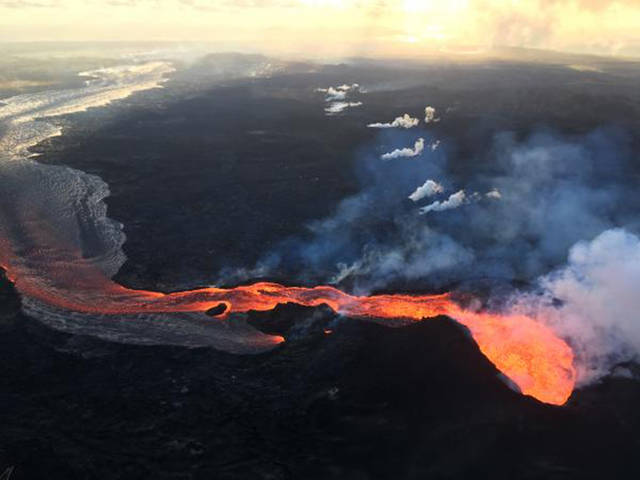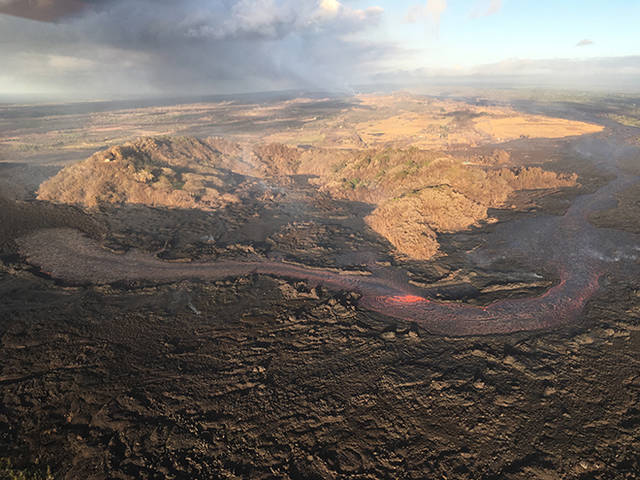Kilauea Volcano’s heat triggering mass amounts of acid rain

COURTESY USGS
This aerial U.S. Geological Survey photo from Sunday shows fissure 8 and its open lava channel leading to the northeast. Sulfur dioxide emissions from the ongoing Kilauea volcano eruption led to acidic rain falling in parts of the Lower Puna area this weekend.

COURTESY USGS
This aerial U.S. Geological Survey photo from Sunday shows a view of the partially filled Kapoho Crater in Lower Puna and the open fissure 8 lava channel where it makes a 90-degree turn around the crater. The open channel no longer directly enters the ocean, USGS scientists say, adding that lava flows freely through the channel only to the southern edge of Kapoho Crater at left.


Intense, hot air from the ongoing Kilauea eruption — combined with a drop in tradewinds — triggered 9.22 inches of rain containing sulfur dioxide to drench an isolated portion of the lower East Rift Zone in the 24 hours that ended at 8 Monday morning.
“The heat coming out of the lava is making the air mass really unstable,” said National Weather Service meteorologist John Bravender. “We’re not seeing it all the time, but it’s cropping up part of the time.”
The forecast of a return to more conventional tradewind patterns mean heavy rain over the lower East Rift Zone were likely to dissipate as early as Monday night, Bravender said.
In the meantime, he said, as “the lava heats up and rises,” it then cools higher in the atmosphere, turns into condensation, then falls as heavy rain that’s “just localized to the specific area where it’s most unstable,” Bravender said.
Tina Neal, scientist-in- charge of the U.S. Geological Survey’s Hawaiian Volcano Observatory, said ongoing emissions of sulfur dioxide from the 8-mile river of lava likely are falling as “acidic rain” downwind of fissure 8.
No measurements have been taken to determine the level of sulfur dioxide in the rainfall, Neal said.
Don't miss out on what's happening!
Stay in touch with breaking news, as it happens, conveniently in your email inbox. It's FREE!
But, she said, “that rain is acidic. … That likely is occurring.”
Also Monday morning, the ongoing collapse of Halemaumau Crater from the Kilauea eruption triggered another “explosive event” equal to a 5.3-magnitude earthquake, according to HVO.
As in past “explosive events,” the number of temblors suddenly dropped from 25 to 40 an hour to fewer than 10 an hour following the 9:21 a.m. shaking, which occurred during an operations meeting at Hawai‘i Volcanoes National Park.
Scientists at HVO expect the number of earthquakelike events to increase over the next 24 hours until the next “explosive event,” which is expected sometime today as the rim and walls of Halemaumau continue to collapse.
The Pacific Tsunami Warning Center said there was no tsunami threat.
But all of the shaking Friday opened up “a fairly large sinkhole” on Highway 11 leading into Hawai‘i Volcanoes National Park, which has now been shuttered for 60 days, said park spokeswoman Jessica Ferracane.
Highway 11 had to be closed down to one lane as state Department of Transportation crews repaired the damage by Monday morning, which included the installation of a steel plate, Ferracane said.
Highway 11 now has a “noticeable big bump and dip” over the old sinkhole, and cracks continue to appear in roads throughout the park, Ferracane said.




